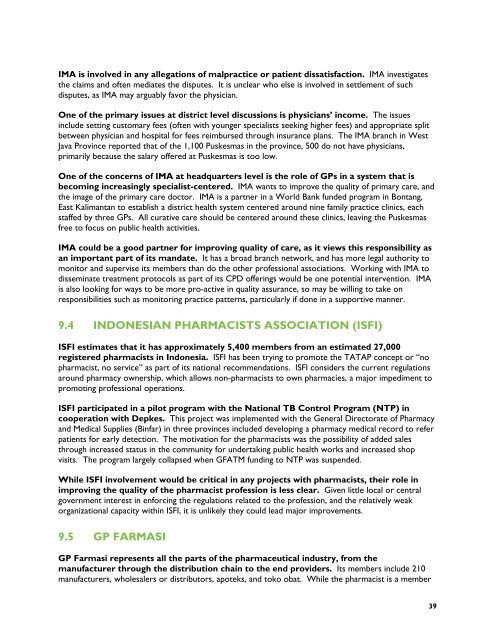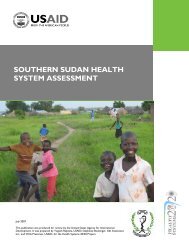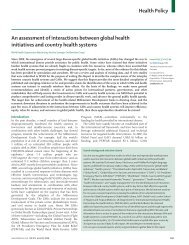get the necessary recommendation from IBI to practice if they do not pass the exam. In a change ofpolicy, new graduates who pass the exam are able to set up independent practices immediately, withoutthe previously required experience at either a Puskesmas or hospital.Of all the professional associations, IBI is the most active in monitoring and supervision ofprivate practices. IBI chapter leaders were involved in joint monitoring in all of the assessmentdistricts. Generally, respondents reported monitoring visits twice a year. Perhaps as a result of thehistory of efforts to strengthen MCH, most districts have a Midwife Coordinator. Based on thisassessment and other studies, midwives seem to provide regular reports to district health officials,unlike other types of providers (despite significant scope to improve the accuracy and completeness ofthese reports).Two important issues in discussions of midwives include institutionalizing the practice ofreferral and the quality of midwifery education. In both Bandung and Yogyakarta districts, one ofthe issues of concern to midwives was the lack of reimbursement from Askes or Jamkesmas for patientswho are referred to hospitals for delivery because of complications. Midwives in Yogyakarta noted thatnot only are they not reimbursed for their time and direct costs (such as IVs used) up to the time ofreferral, but sometimes the patient is then discharged back to her care after having a Caesarean section.In Bandung, midwives reported that if there is hemorrhage after delivery has occurred, once the patientis referred to hospital, she receives no reimbursement. In order to institutionalize appropriate referral,setting a clearer standard for referral, as well as providing reimbursement for services prior to referralare critical elements. IBI also is concerned with the quality of private education, as there are many newmidwifery academies in recent years. There is a World Bank project with the Ministry of Education todevelop education standards and a system for accrediting training institutes.There is great potential in working with IBI to improve the quality of MCH services. Theirmembers are the main providers of prenatal care, delivery, and newborn care. In three of the fourassessment districts, private midwives accepted Jamkesmas or a district financing scheme for payment.Working through IBI to develop and disseminate standard clinical protocols, and working withJamkesmas and district financing schemes to provide financial incentives to follow those protocols couldprovide significant improvements in MCH outcomes, specifically benefitting the poor and near poor.9.3 <strong>IN</strong>DONESIAN MEDICAL ASSOCIATION (IMA)IMA was legislatively given the responsibility of overseeing the quality of physicians. IMAhas been working to fulfill this responsibility with the introduction of a competency exam prior tolicensing, and requirements for CPD credits prior to re-licensing. Districts require an IMArecommendation before a doctor can be officially licensed, allowing IMA to control both the quality andquantity of physicians. IMA also maintains and updates a set of clinical practice guidelines, but has notbeen active in enforcing these clinical guidelines. There are currently 74,000 licensed doctors,approximately 30 percent of whom are specialists.IMA at all levels is entirely operated by volunteers, with the exception of a few supportstaff. There are 343 IMA branches, with a branch in most districts. Its branch offices are not involvedin monitoring or supervision of doctors, but often organize CPD training for its members, which arepaid by the doctors attending and corporate sponsorship. All levels (headquarters, province, anddistrict) hold regular meetings for its members. Provinces also meet regularly with their districtbranches – monthly in Yogyakarta. Membership fees are Rp 10,000 per month, but the payment rate isvery low, although improving.38
IMA is involved in any allegations of malpractice or patient dissatisfaction. IMA investigatesthe claims and often mediates the disputes. It is unclear who else is involved in settlement of suchdisputes, as IMA may arguably favor the physician.One of the primary issues at district level discussions is physicians’ income. The issuesinclude setting customary fees (often with younger specialists seeking higher fees) and appropriate splitbetween physician and hospital for fees reimbursed through insurance plans. The IMA branch in WestJava Province reported that of the 1,100 Puskesmas in the province, 500 do not have physicians,primarily because the salary offered at Puskesmas is too low.One of the concerns of IMA at headquarters level is the role of GPs in a system that isbecoming increasingly specialist-centered. IMA wants to improve the quality of primary care, andthe image of the primary care doctor. IMA is a partner in a World Bank funded program in Bontang,East Kalimantan to establish a district health system centered around nine family practice clinics, eachstaffed by three GPs. All curative care should be centered around these clinics, leaving the Puskesmasfree to focus on public health activities.IMA could be a good partner for improving quality of care, as it views this responsibility asan important part of its mandate. It has a broad branch network, and has more legal authority tomonitor and supervise its members than do the other professional associations. Working with IMA todisseminate treatment protocols as part of its CPD offerings would be one potential intervention. IMAis also looking for ways to be more pro-active in quality assurance, so may be willing to take onresponsibilities such as monitoring practice patterns, particularly if done in a supportive manner.9.4 <strong>IN</strong>DONESIAN PHARMACISTS ASSOCIATION (ISFI)ISFI estimates that it has approximately 5,400 members from an estimated 27,000registered pharmacists in Indonesia. ISFI has been trying to promote the TATAP concept or “nopharmacist, no service” as part of its national recommendations. ISFI considers the current regulationsaround pharmacy ownership, which allows non-pharmacists to own pharmacies, a major impediment topromoting professional operations.ISFI participated in a pilot program with the National TB Control Program (NTP) incooperation with Depkes. This project was implemented with the General Directorate of Pharmacyand Medical Supplies (Binfar) in three provinces included developing a pharmacy medical record to referpatients for early detection. The motivation for the pharmacists was the possibility of added salesthrough increased status in the community for undertaking public health works and increased shopvisits. The program largely collapsed when GFATM funding to NTP was suspended.While ISFI involvement would be critical in any projects with pharmacists, their role inimproving the quality of the pharmacist profession is less clear. Given little local or centralgovernment interest in enforcing the regulations related to the profession, and the relatively weakorganizational capacity within ISFI, it is unlikely they could lead major improvements.9.5 GP FARMASIGP Farmasi represents all the parts of the pharmaceutical industry, from themanufacturer through the distribution chain to the end providers. Its members include 210manufacturers, wholesalers or distributors, apoteks, and toko obat. While the pharmacist is a member39
- Page 1:
PRIVATE SECTOR HEALTHCARE IN INDONE
- Page 5:
PRIVATE SECTOR HEALTH CAREIN INDONE
- Page 8 and 9:
7. Rationalizing Use of Medications
- Page 11 and 12: ABBREVIATIONSANCAskesAskeskinAusAID
- Page 13: THEUSAIDVATWHOTotal health expendit
- Page 17 and 18: EXECUTIVE SUMMARYAs documented in I
- Page 19 and 20: By using their power to select whic
- Page 21: higher reimbursement for complex de
- Page 25 and 26: 2. BACKGROUND2.1 GENERAL BACKGROUND
- Page 27 and 28: While decentralization of the healt
- Page 29: FIGURE 1: TOTAL EXPENDITURES ON HEA
- Page 32 and 33: poor, which only allows use of publ
- Page 34 and 35: Lack of overall investment in healt
- Page 36 and 37: • Pharmacists and drugsellers - A
- Page 38 and 39: 4.2 ASSESSMENT APPROACHData collect
- Page 40 and 41: practice, however, limited resource
- Page 42 and 43: Dinas to the hospital detailing the
- Page 44 and 45: Unlike Muhammadiyah and NU faciliti
- Page 46 and 47: TABLE 3: POPULATION COVERAGE BY HEA
- Page 48 and 49: customary fees. At the same time, i
- Page 51 and 52: 7. RATIONALIZING USE OFMEDICATIONS7
- Page 53 and 54: too few medicines to meet the publi
- Page 55 and 56: 8. PHARMACISTS ANDDRUGSELLERS AS PA
- Page 57 and 58: district provides TB drugs to priva
- Page 59: 9. ROLE OF PROFESSIONALASSOCIATIONS
- Page 63 and 64: 10. CONCLUSIONS ANDRECOMMENDATIONSI
- Page 65: If Indonesia is to achieve its prio
- Page 68 and 69: • Supporting the mapping of all f
- Page 71 and 72: ANNEX A: ASSESSMENT GUIDEIndonesia
- Page 73 and 74: Key Informants at Provincial LevelK
- Page 75: Key InformantsoooIBI, and memberrep
- Page 78 and 79: Assessment Question Approach/Backgr
- Page 80 and 81: Indicator Number Data Source and No
- Page 82 and 83: 1.3.4 DinKes Experience with Privat
- Page 84 and 85: The team interviewed a manager 16 a
- Page 86 and 87: They have used many different healt
- Page 88 and 89: In Yogyakarta Province, there are 1
- Page 90 and 91: graduates to work immediately in 24
- Page 92 and 93: Muhammadiyah is a 226 bed hospital
- Page 94 and 95: Dinas Yogyakarta31. Mardiningsih, S
- Page 96 and 97: 2.1 Provincial InformationThe popul
- Page 98 and 99: How can services provided at privat
- Page 100 and 101: The Provincial Health Office meets
- Page 102 and 103: from multiple sources: 40 percent f
- Page 104 and 105: 2.9 Licensing and Oversight of Phar
- Page 106 and 107: As per IMA Propinsi, they meet with
- Page 108 and 109: It was mentioned that the budget fo
- Page 110 and 111:
• Private midwives are willing to
- Page 112 and 113:
etween PKBI and the District Health
- Page 114 and 115:
Cahya Kawaluyan Hospital has adapte
- Page 116 and 117:
the midwife to charge a slightly hi
- Page 118 and 119:
Involving Physicians in DOTS. A sig
- Page 120 and 121:
Ikatan Bidan Indonesia (IBI) West J
- Page 122 and 123:
Indicator DKI West Jakarta Data Sou
- Page 124 and 125:
visited an average of over 60 perce
- Page 126 and 127:
3.9 Potential role of professional
- Page 128 and 129:
members who pay membership fees. Th
- Page 130 and 131:
emainder paying out of pocket. Reve
- Page 132 and 133:
3.20 Indonesian Pharmacists Associa
- Page 134 and 135:
OtherApotek Gitamara, Jl. Kemanggis
- Page 136 and 137:
13. Government of Indonesia, World
- Page 138:
41. Thrabany, Hasbullah, et al. 200
















